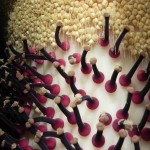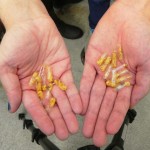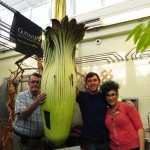
Female and male flowers of the Corpse Flower (Amorphophallus titanum). The lower, purple-red structures are female flowers. The array of yellow structures in the upper part of the photo is a collection of male flowers that are in the process of producing pollen.

Perry’s pollen is now ready for storage for sharing with other institutions that have flowering plants of Amorphophallus titanum and wish to produce seeds via fertilization by a different clone. Yes to outcrossing!

Nate and Serenity collecting pollen from Perry. The tools for collection of hanging pollen are artists’ brushes and waxed paper. Tools for fallen pollen are plastic spoons and small spatulas that usually have more chemistry-intensive uses.

Serenity and Nate collecting pollen from Perry. The tools for collection of hanging pollen are artists’ brushes and waxed paper. Tools for fallen pollen are plastic spoons and small spatulas that usually have more chemistry-intensive uses.
Perry the Corpse Flower is a mom and dad!
Here’s a partial explanation of the title of this post. Perry the Corpse Flower’s underground part is called a corm. It is a solid structure that’s similar to a potato, but it has only one eye. The corm weighed 90 pounds when we repotted Perry in 2006. It is doubtless much heavier now (150 pounds or more?). What we have here, within Perry’s pot, is the equivalent of a 150-pound one-eyed potato. Perry has once again produced male and female flowers, including pollen – children of the corm. Children of the Corn is a different concept.
We [Serenity Mahoney (Gustavus ’15), Nate Friedley (Gustavus ’15) and I] collected pollen from Perry yesterday. A window was chopped out in the base of Perry’s spathe with a razor blade on the second day of blooming so that visitors could see Perry’s internal structure (Friday, November 1, honors done by Professor Cindy Johnson of our Biology Department). Further incisions and extractions were made on Perry on Saturday afternoon – the original window was enlarged, and a second window 180 degrees to the first one was cut, followed by pollen collection, with the actions being done by Nate and Serenity. More to come on dissection of Perry later, including graphic photos. The pollen will be stored so that it can be shared with other institutions that have blooming Amorphophallus titanum plants, so that seeds can be produced. Perry’s genetic heritage will thus be shared. Yes to outcrossing!
Here’s a bit of Perry biology that will clarify this ritual: Amorphophallus titanum produces both male and female flowers within the structure that everyone sees and that looks like a giant flower. The structure is actually an inflorescence – a cluster of flowers, or, if you prefer, a bouquet. Perry’s flowers are at the base of the spadix (the tall, stiff, columnar structure) that arises from the center of the spathe (the leafy, surreally-lettuce-like structure that surrounds the spadix like an inverted raggedy lampshade). The myriad individual flowers are at the base of the spadix. The red-purple female flowers (which look a bit like cloves or matchsticks) form a ring at the bottom of the spadix. The tiny, yellow, closely-packed male flowers form a second ring above the female flowers, and produce the pollen.
Ok – enough background. Take a look at the pictures and their captions. This has been a wonderful experience!
